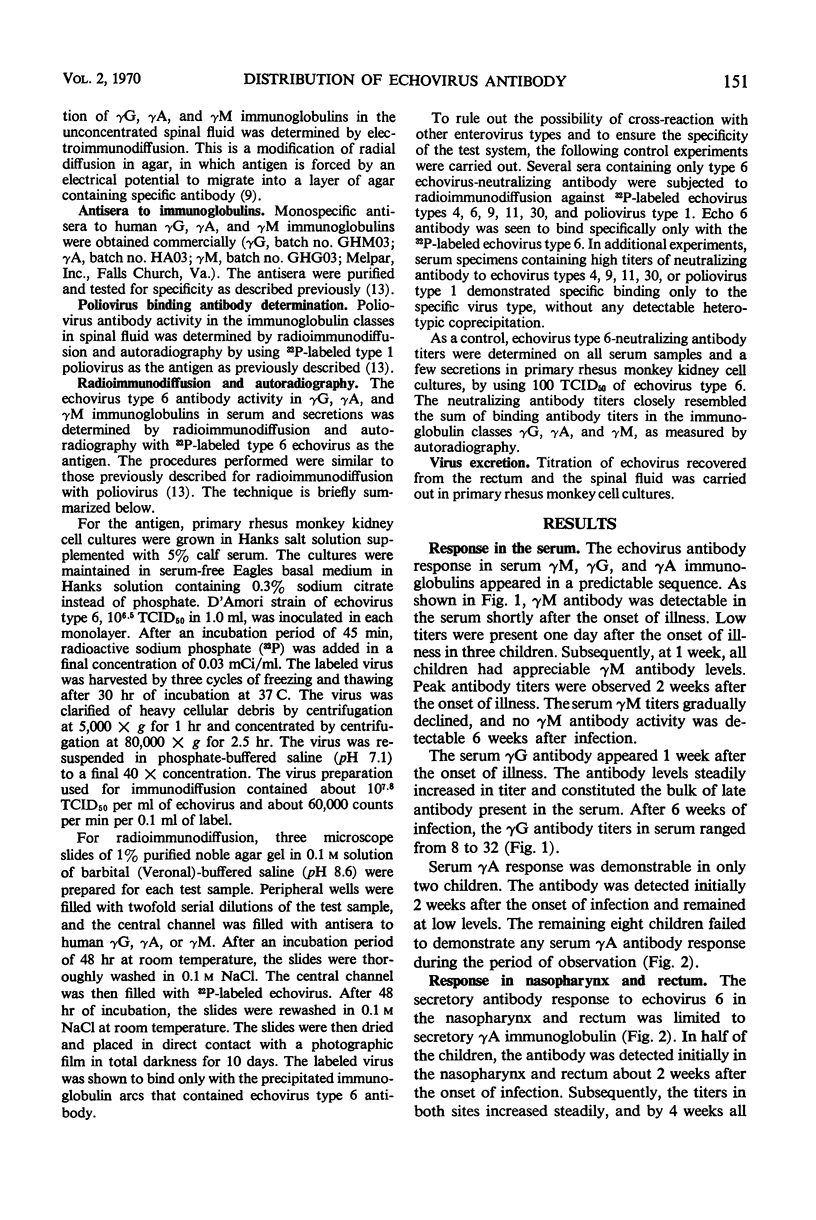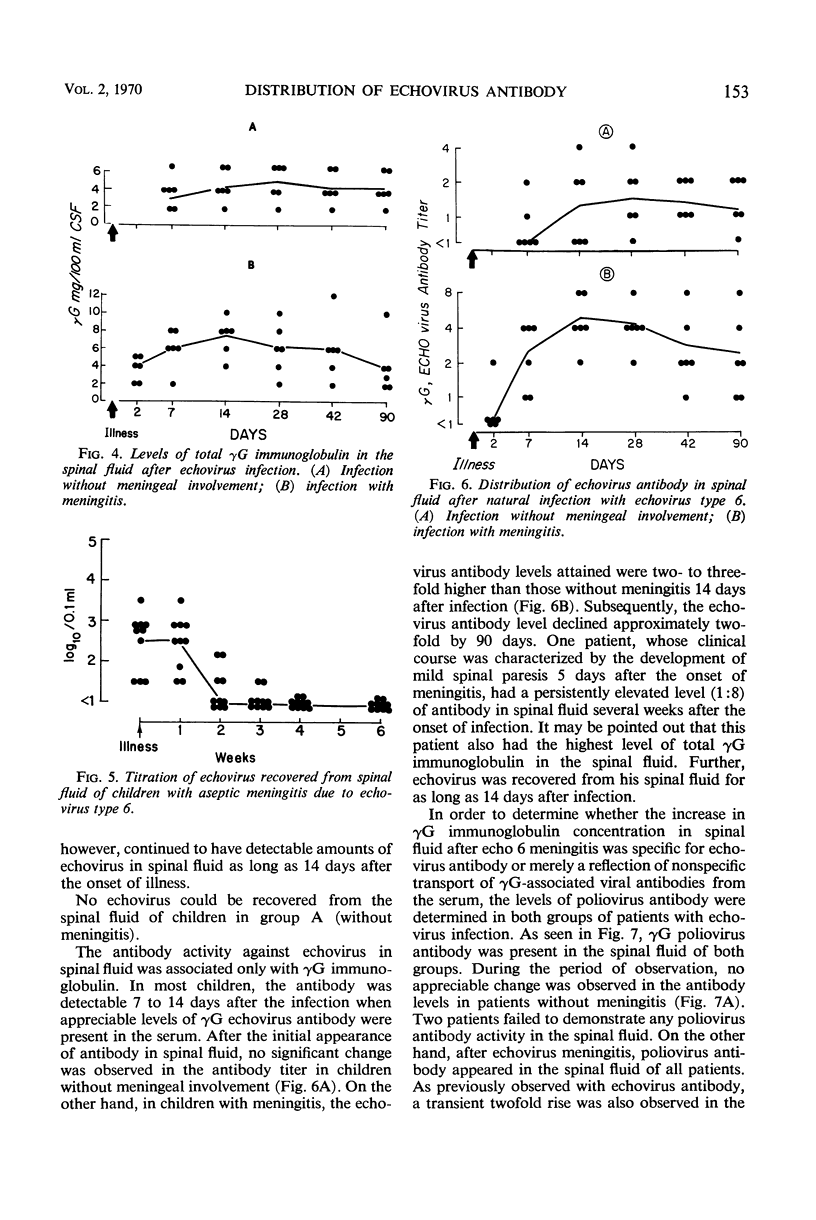Abstract
By employing the techniques of radioimmunodiffusion and autoradiography and by using 32P-labeled echovirus 6 as the antigen, the distribution of echovirus 6 antibody in serum, nasopharynx, rectum, and spinal fluid was studied in a group of children with naturally acquired echovirus type 6 infection, with or without meningeal involvement. The response in serum was characterized by sequential appearance of γM, γG, and rarely of γA antibody. The secretory response in the nasopharynx and rectum was limited to secretory γA immunoglobulin. The response in spinal fluid was limited to γG immunoglobulin. γG echovirus antibody appeared in the spinal fluid with or without demonstrable replication of virus in the spinal fluid. It is suggested that, after short-term acute infection with enteroviruses, the appearance of γG antibody in spinal fluid may largely be a reflection of increased transport of serum antibody, particularly of γG immunoglobulin class.
Full text
PDF





Selected References
These references are in PubMed. This may not be the complete list of references from this article.
- Bellanti J. A., Sanga R. L., Klutinis B., Brandt B., Artenstein M. S. Antibody responses in serum and nasal secretions of children immunized with inactivated and attenuated measles-virus vaccines. N Engl J Med. 1969 Mar 20;280(12):628–633. doi: 10.1056/NEJM196903202801202. [DOI] [PubMed] [Google Scholar]
- Genco R. J., Taubman M. A. Secretory gamma-A antibodies induced by local immunization. Nature. 1969 Feb 15;221(5181):679–681. doi: 10.1038/221679a0. [DOI] [PubMed] [Google Scholar]
- Hartley T. F., Merrill D. A., Claman H. N. Quantitation of immunoglobulins in cerebrospinal fluid. Arch Neurol. 1966 Nov;15(5):472–479. doi: 10.1001/archneur.1966.00470170026003. [DOI] [PubMed] [Google Scholar]
- Heffner R. R., Jr, Schluederberg A. Specificity of the primary and secondary antibody responses to myxoviruses. J Immunol. 1967 Apr;98(4):668–672. [PubMed] [Google Scholar]
- Keller R., Dwyer J. E. Neutralization of poliovirus by IgA coproantibodies. J Immunol. 1968 Aug;101(2):192–202. [PubMed] [Google Scholar]
- Knopf H. L., Perkins J. C., Bertran D. M., Kapikian A. Z., Chanock R. M. Analysis of the neutralizing activity in nasal wash and serum following intranasal vaccinaion with inactivated type 13 rhinovirus. J Immunol. 1970 Mar;104(3):566–573. [PubMed] [Google Scholar]
- Merrill D., Hartley T. F., Claman H. N. Electroimmunodiffusion (EID): a simple, rapid method for quantitation of immunoglobulins in dilute biological fluids. J Lab Clin Med. 1967 Jan;69(1):151–159. [PubMed] [Google Scholar]
- Ogra P. L., Karzon D. T. Distribution of poliovirus antibody in serum, nasopharynx and alimentary tract following segmental immunization of lower alimentary tract with poliovaccine. J Immunol. 1969 Jun;102(6):1423–1430. [PubMed] [Google Scholar]
- Ogra P. L., Karzon D. T. Poliovirus antibody response in serum and nasal secretions following intranasal inoculation with inactivated poliovaccine. J Immunol. 1969 Jan;102(1):15–23. [PubMed] [Google Scholar]
- SVEHAG S. E., MANDEL B. THE FORMATION AND PROPERTIES OF POLIOVIRUS-NEUTRALIZING ANTIBODY. II. 19S AND 7S ANTIBODY FORMATION: DIFFERENCES IN ANTIGEN DOSE REQUIREMENT FOR SUSTAINED SYNTHESIS, ANAMNESIS, AND SENSITIVITY TO X-IRRADIATION. J Exp Med. 1964 Jan 1;119:21–39. doi: 10.1084/jem.119.1.21. [DOI] [PMC free article] [PubMed] [Google Scholar]
- Smith C. B., Bellanti J. A., Chanock R. M. Immunoglobulins in serum and nasal secretions following infection with type 1 parainfluenza virus and injection of inactivated vaccines. J Immunol. 1967 Jul;99(1):133–141. [PubMed] [Google Scholar]
- Tomasi T. B., Jr, Bienenstock J. Secretory immunoglobulins. Adv Immunol. 1968;9:1–96. doi: 10.1016/s0065-2776(08)60441-1. [DOI] [PubMed] [Google Scholar]
- UHR J. W., FINKELSTEIN M. S. Antibody formation. IV. Formation of rapidly and slowly sedimenting antibodies and immunological memory to bacteriophage phi-X 174. J Exp Med. 1963 Mar 1;117:457–477. doi: 10.1084/jem.117.3.457. [DOI] [PMC free article] [PubMed] [Google Scholar]


